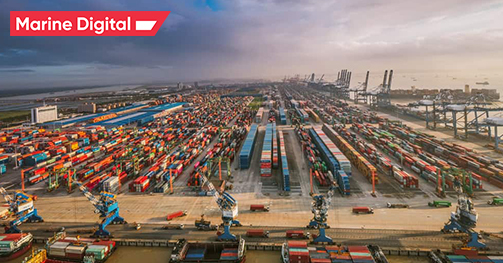The World's Biggest Shipping Hubs
Data from the Hong Kong Marine Department shows that ports in Asia, especially in China, are increasingly dominating the industry.
Let's see what are the largest transport hubs in the world today
Let's see what are the largest transport hubs in the world today
The volume of goods transported around the globe by container ships has increased continuously in recent years. Data from the Hong Kong Marine Department shows that ports in Asia, especially in China, are increasingly dominating the industry. In 2005, there were still two European and one North American port in the ranking of the biggest shipping hubs in the world. In 2021, only Rotterdam remained in the top 10 – in the bottom rank.

Let's see what are the largest transport hubs in the world today
The Port of Shanghai is the world's busiest and biggest port. It's been in existence for 180 years but became the world's leading port only in 2010 when it surpassed the Port of Singapore as the world's busiest port, it has been the world's busiest port. It has presently achieved its cargo handling target of 47 million TEUs a year.
The Shanghai port's entire area amounts to a staggering 3,619km² while its quay length is more than 20km long. In possession of 125 wharves spanning over 19 terminals, the port is able to serve about 2,000 container vessels on a monthly level.
In late 2017, the Port of Shanghai became home to the Shanghai Yangshan Deep Water Port – the world's largest freight terminal with an automated shipping load/unload system.
There's also a terminal for cruise ships where about 1 million people per year arrive to visit the city of Shanghai.
The Shanghai port's entire area amounts to a staggering 3,619km² while its quay length is more than 20km long. In possession of 125 wharves spanning over 19 terminals, the port is able to serve about 2,000 container vessels on a monthly level.
In late 2017, the Port of Shanghai became home to the Shanghai Yangshan Deep Water Port – the world's largest freight terminal with an automated shipping load/unload system.
There's also a terminal for cruise ships where about 1 million people per year arrive to visit the city of Shanghai.
1. Port of Shanghai, China

IN 2021, Singapore's container throughput rose to a new record high of 37.5 million 20-foot equivalent units (TEUs), helping the Republic to retain its pole position as the world's busiest container transshipment port.
This port is connected to over 600 other ports in the world from more than 120 countries. That makes the port responsible for a fifth of the global freight trade.
In total, Singapore handled 599 million tonnes of freight in 2021, higher than the 2020 numbers but lower than those in some of the years pre-pandemic, according to the Maritime and Port Authority of Singapore (MPA) data.
Vessel arrival reached 2.81 billion gross tonnages, marginally lower than that clocked in 2020.
The Singapore Registry of Ships is ranked among the top five ship registries in the world, with the total tonnage of ships under the Singapore flag standing at 92.3 million gross tonnages as of December 2021.
This port is connected to over 600 other ports in the world from more than 120 countries. That makes the port responsible for a fifth of the global freight trade.
In total, Singapore handled 599 million tonnes of freight in 2021, higher than the 2020 numbers but lower than those in some of the years pre-pandemic, according to the Maritime and Port Authority of Singapore (MPA) data.
Vessel arrival reached 2.81 billion gross tonnages, marginally lower than that clocked in 2020.
The Singapore Registry of Ships is ranked among the top five ship registries in the world, with the total tonnage of ships under the Singapore flag standing at 92.3 million gross tonnages as of December 2021.
2. Port of Singapore, Singapore

Famous for being the world's busiest container port regarding cargo tonnage (over 1 billion tons in 2018), the Port of Ningbo-Zhoushan is also the oldest seaport in China (dating from the 5th century AD).
The port is connected to more than 590 other ports from about 100 countries on all 6 continents. It possesses 191 berths (39 of which are deep-water berths) packed with 204 quay cranes, thus capable of receiving maritime traffic of more than 160,000 container vessels annually.
The cargo volume in Ningbo Zhoushan Port has grown rapidly since 2005. In 2019, the container throughput of Ningbo Zhoushan Port reached 27.535 million TEUs (in 2021 already 31.1 million TEU), standing firmly in 3rd place in the world. The total cargo throughput reached 1.12 billion tons, ranking 1st worldwide for 11 consecutive years.
The port is connected to more than 590 other ports from about 100 countries on all 6 continents. It possesses 191 berths (39 of which are deep-water berths) packed with 204 quay cranes, thus capable of receiving maritime traffic of more than 160,000 container vessels annually.
The cargo volume in Ningbo Zhoushan Port has grown rapidly since 2005. In 2019, the container throughput of Ningbo Zhoushan Port reached 27.535 million TEUs (in 2021 already 31.1 million TEU), standing firmly in 3rd place in the world. The total cargo throughput reached 1.12 billion tons, ranking 1st worldwide for 11 consecutive years.
3. Port of Ningbo-Zhoushan, China

The Port of Shenzhen is one of the largest ports in China. It has great development opportunities and, what is more, it is also one of the busiest ports in the world. It is in the top 10 among the largest container ports in the world (in terms of TEU). The Port of Shenzhen consists of the ports of Shekou, Chiwan, Yantian, Mawan, Shayuchong, Da Chan Bay, Dongjiaotou, Fuyong, Neihe, and Xiadong.
Even though this port is prominent in transshipment services by connecting over 100 countries through more than 300 shipping routes, its main trade throughput and ferry services come from the neighboring cities in the Pearl River Delta (Hong Kong, Zhuhai, and Macao).
The international trade sector has shown great interest in the Port of Shenzhen and companies like UPS, DHL, Kerry Logistics, and Nippon Express have established their own warehouses there.
The Shenzhen region is famous for its technological development, therefore, besides the many shipping companies, tech giants such as Tencent, Huawei, and SenseTime have headquartered their offices there.
Even though this port is prominent in transshipment services by connecting over 100 countries through more than 300 shipping routes, its main trade throughput and ferry services come from the neighboring cities in the Pearl River Delta (Hong Kong, Zhuhai, and Macao).
The international trade sector has shown great interest in the Port of Shenzhen and companies like UPS, DHL, Kerry Logistics, and Nippon Express have established their own warehouses there.
The Shenzhen region is famous for its technological development, therefore, besides the many shipping companies, tech giants such as Tencent, Huawei, and SenseTime have headquartered their offices there.
4. Port of Shenzhen, China

The world's fifth-largest container port in 2018, with 24.5 million TEUs, the Port of Guangzhou is the main seaport of Guangzhou city, Guangdong province, China. The Port of Guangzhou incorporates several smaller ports into its infrastructure. The three main ports are Nansha, Xinsha, and Huangpu, and there's also the Downtown Port area consisting of three terminals for handling commercial cargo.
Like the Shenzhen port, this major facility processes trade within the province of Guangdong and its services as a vital instrument for the trade of the industries from several neighboring provinces including Hubei, Guangxi, Sichuan, Yunnan, Hunan, Guizhou, and Jiangxi.
Nansha, the deepwater port of the Port of Guangzhou, is responsible for handling over 70% of the maritime traffic that passes through the entire port area.
The Port of Nansha contributes more than 70% of the total cargo volume in China's Port of Guangzhou. Nansha Terminal operates more than fifteen 150,000-ton berths, with a total quay length of 5,728 meters. It is equipped with more than 60 cranes, with the ability to handle nearly two dozen rows of containers. Nansha Terminal is capable of accommodating such Mega Vessels as CMA-CGM's Ben Franklin.
Like the Shenzhen port, this major facility processes trade within the province of Guangdong and its services as a vital instrument for the trade of the industries from several neighboring provinces including Hubei, Guangxi, Sichuan, Yunnan, Hunan, Guizhou, and Jiangxi.
Nansha, the deepwater port of the Port of Guangzhou, is responsible for handling over 70% of the maritime traffic that passes through the entire port area.
The Port of Nansha contributes more than 70% of the total cargo volume in China's Port of Guangzhou. Nansha Terminal operates more than fifteen 150,000-ton berths, with a total quay length of 5,728 meters. It is equipped with more than 60 cranes, with the ability to handle nearly two dozen rows of containers. Nansha Terminal is capable of accommodating such Mega Vessels as CMA-CGM's Ben Franklin.
5. Port of Guangzhou, China

The Port of Qingdao commenced operations in 1892. Located between the Bohai Rim port region and the Yangtze River Delta port region in the PRC and occupied a central position among ports in Northeast Asia, the Port of Qingdao is one of the most comprehensive ports in the world, and an important hub for international trade and transportation in the West Pacific.
Its four major terminals include the Dagang, the Qianwan, the Dongjiakou, and the Huangdao port areas. Together, they're capable of handling more than 500 million tons.
With its 96 operational berths, the Port of Qingdao is also famous for being partially automated and appropriately equipped for ample, heavy-lifting cranes.
Its four major terminals include the Dagang, the Qianwan, the Dongjiakou, and the Huangdao port areas. Together, they're capable of handling more than 500 million tons.
With its 96 operational berths, the Port of Qingdao is also famous for being partially automated and appropriately equipped for ample, heavy-lifting cranes.
6. Port of Qingdao, China

The Port of Busan is the largest port in South Korea, located in the city of Busan.
Also known as the Busan Harbor, the port was opened in 1876 as a small facility with the purpose of handling trade between Korea, China, and Japan.
The port is ranked sixth in the world's container throughput and is the largest seaport in South Korea. The port is operated by the Busan Port Authority, which was founded in 2004 as a public company. In 2019, 22.7 million TEU were handled at 10 container terminals in Busan.
Comprised of four smaller ports and two terminals, the Port of Busan's main trade partners are Japan, the United States, China, Vietnam, Germany, and Hong Kong.
This port may be sixth on our list, but is, in fact, third in the world when it comes to transshipment trade. The South Korean government makes huge investments to further expand these operations and push the Port of Busan to the second spot in the transshipment industry.
Also known as the Busan Harbor, the port was opened in 1876 as a small facility with the purpose of handling trade between Korea, China, and Japan.
The port is ranked sixth in the world's container throughput and is the largest seaport in South Korea. The port is operated by the Busan Port Authority, which was founded in 2004 as a public company. In 2019, 22.7 million TEU were handled at 10 container terminals in Busan.
Comprised of four smaller ports and two terminals, the Port of Busan's main trade partners are Japan, the United States, China, Vietnam, Germany, and Hong Kong.
This port may be sixth on our list, but is, in fact, third in the world when it comes to transshipment trade. The South Korean government makes huge investments to further expand these operations and push the Port of Busan to the second spot in the transshipment industry.
7. Port of Busan, South Korea

The port of Tianjin, located at the juncture of the Beijing-Tianjin city belt and the economic circle of the Bohai Rim Region, is the largest comprehensive port and an important foreign trade port in North China, serving 14 provinces, cities and autonomous regions and a hub connecting Northeast Asia with Midwest Asia. It is one of the coastal ports with the most complete functions in China.
Being a thoroughly man-made port, this artificial port establishment is the biggest in China by spanning over 131 square kilometers and having a 34-kilometer-long quay.
The Port of Tianjin boasts 170 cargo berths which in 2021 were able to handle about 20.3 million TEUs. Ships of various sizes can be docked at its 6 anchorages and have their cargo processed at nine container terminals. There are also two terminals for passengers who arrive or depart the port.
The port's progress was delayed for a while in 2015 after a series of explosions caused by chemical compounds stored at the port caught fire and killed 173 people and injured more than 800 others.
Being a thoroughly man-made port, this artificial port establishment is the biggest in China by spanning over 131 square kilometers and having a 34-kilometer-long quay.
The Port of Tianjin boasts 170 cargo berths which in 2021 were able to handle about 20.3 million TEUs. Ships of various sizes can be docked at its 6 anchorages and have their cargo processed at nine container terminals. There are also two terminals for passengers who arrive or depart the port.
The port's progress was delayed for a while in 2015 after a series of explosions caused by chemical compounds stored at the port caught fire and killed 173 people and injured more than 800 others.
8. Port of Tianjin, China

The Port of Hong Kong handles over five million TEU of transshipped products each year and 17.80 million TEU in total in 2021, making it the world's ninth busiest port.
This port, located on the South China Sea, is a deepwater shipping center focused on the transshipment of containerized manufactured goods, raw materials and passengers.
Even though the Port of Hong Kong has one of the smallest areas for shipment processing and storage (2.790 square kilometers), it is still very capable of supplying the entire administrative region of Hong Kong with the necessary demand and connecting its harbor with more than 470 other ports in the world.
Being an island nation, this port is responsible for supplying about 90% of the country's total cargo.
Hong Kong, formerly the world's busiest port, has been left behind by China's industrial and export growth.
This port, located on the South China Sea, is a deepwater shipping center focused on the transshipment of containerized manufactured goods, raw materials and passengers.
Even though the Port of Hong Kong has one of the smallest areas for shipment processing and storage (2.790 square kilometers), it is still very capable of supplying the entire administrative region of Hong Kong with the necessary demand and connecting its harbor with more than 470 other ports in the world.
Being an island nation, this port is responsible for supplying about 90% of the country's total cargo.
Hong Kong, formerly the world's busiest port, has been left behind by China's industrial and export growth.
9. Port of Hong Kong

The Port of Rotterdam is the largest seaport in Europe, and the world's largest seaport outside of East Asia, located in and near the city of Rotterdam, in the province of South Holland in the Netherlands. From 1962 until 2004, it was the world's busiest port by annual cargo tonnage. It was overtaken first in 2004 by the port of Singapore, and since then by Shanghai and other very large Chinese seaports. In 2020, Rotterdam was the world's tenth-largest container port in terms of twenty-foot equivalent units (TEU) handled.
Rotterdam consists of five distinct port areas and three distribution parks that facilitate the needs of a hinterland with over 50,000,000 consumers throughout the continent of Europe.
The Rotterdam Port is one of the most modern ports in the world as well. The port's terminals feature berths that are largely computerized and employ robotic cranes and autonomous chariots. There are all kinds of sensors throughout the port for identification, sorting, and storing containers, whose data is collected and processed by a cloud-based platform.
Read more about TOP-15 significant seaports for global logistics
Marine Digital is developing a fleet intelligence platform that allows you to optimize just-in-time arrivals and, accordingly, reduce ship fuel consumption and emissions in ports. Get 2 months free trial access to benchmark ports, monitor navigation efficiency, and manage CII, EEOI and SEEMP.
Rotterdam consists of five distinct port areas and three distribution parks that facilitate the needs of a hinterland with over 50,000,000 consumers throughout the continent of Europe.
The Rotterdam Port is one of the most modern ports in the world as well. The port's terminals feature berths that are largely computerized and employ robotic cranes and autonomous chariots. There are all kinds of sensors throughout the port for identification, sorting, and storing containers, whose data is collected and processed by a cloud-based platform.
Read more about TOP-15 significant seaports for global logistics
Marine Digital is developing a fleet intelligence platform that allows you to optimize just-in-time arrivals and, accordingly, reduce ship fuel consumption and emissions in ports. Get 2 months free trial access to benchmark ports, monitor navigation efficiency, and manage CII, EEOI and SEEMP.
10. Port of Rotterdam, The Netherlands



Feel free to address any questions on this topic to our expert

TOP 5 factors contributing to lower fuel costs for Shipping companies
Get a presentation with a full description of the features and free pilot project with trial of Marine Digital FOS for 2 months
"Clicking the button, you consent to the processing of personal data and agree to the privacy policy"

Get an overview "The Pathway to Zero Carbon Shipping:
IMO Compliance and CII Optimization through SEEMP" on email and download it for FREE! Leave your email now!
"Clicking the button, you consent to the processing of personal data and agree to the privacy policy, as well as consent to subscribe to the newsletter. "
Аdvantage of Fuel Optimization System from Marine Digital:

Marine Digital FOS can be integrated with other system and third-party's solutions through the API. To implement vessel performance monitoring for any vessel, we are using mathematical algorithms, machine learning and the same equipment as in FOS. The more data we collect from vessels, the more precise reports and recommendations our system will perform according to your individual requirements in fleet management.
If you have any questions about the solutions and the Marine Digital System platform, write to us, we will be happy to answer
If you have any questions about the solutions and the Marine Digital System platform, write to us, we will be happy to answer

Increased business process speed

Reducing to zero the number of errors

Best offer to the clients

Reduction in operating expenses
Have a questions?




